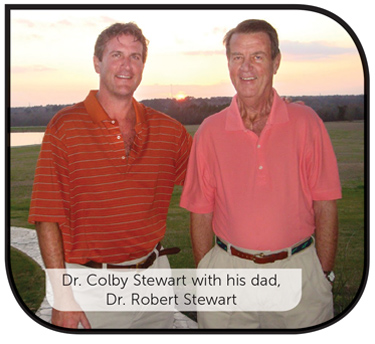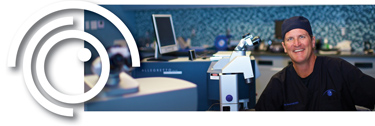
 The late Dr. Robert Stewart was one of the founding doctors of Houston Eye Associates—now the largest ophthalmology group in the United States. While providing some of the best eye care in the country, Dr. Stewart allowed his son, Colby, to spend high school summers working as a technician and scribe in his office. “I learned so much those summers,” says Colby. “My father had a special connection with his patients by educating them, and making them feel at ease.” Today, Dr. Colby Stewart MD has followed in his father’s footsteps at Houston Eye Associates, and has blazed a trail of his own in LASIK and cataract surgery.
The late Dr. Robert Stewart was one of the founding doctors of Houston Eye Associates—now the largest ophthalmology group in the United States. While providing some of the best eye care in the country, Dr. Stewart allowed his son, Colby, to spend high school summers working as a technician and scribe in his office. “I learned so much those summers,” says Colby. “My father had a special connection with his patients by educating them, and making them feel at ease.” Today, Dr. Colby Stewart MD has followed in his father’s footsteps at Houston Eye Associates, and has blazed a trail of his own in LASIK and cataract surgery.
“The advances in both cataract and LASIK surgery in the last few years are astounding,” says Dr. Stewart. “For 40 years, ophthalmologists have been using ultrasound to treat cataracts—the clouding of the natural lens of the eye that occurs with age. Today we are using the latest implant and laser technology to perform ‘refractive’ cataract surgery.” This process removes the cataract, while leaving the patient less dependent on glasses after surgery. The laser is used to break up the cataract and reduce or eliminate corneal astigmatism. Every cataract that is removed will be replaced by an artificial lens or intraocular implant. “New technology” implants are now able to reduce the need for both distance and near glasses. “We are now in a position to clear up the vision from cataracts as well as reduce the dependency on glasses, which is very exciting!” says Dr. Stewart. The surgery is performed under topical anesthesia. No shots, no stitches, no eye patch, and patients can resume their regular activities the following day.
 But wait. Less dependency on glasses or contacts sounds great, but what if you do not have cataracts? “There’s a reason LASIK is such a popular procedure today,” says Dr. Stewart. “It literally changes the way you see the world, in a matter of minutes. Advances in this field have been dramatic. Where we once used a blade to create a thin flap in the cornea we now use the accuracy of a laser.” LASIK successfully treats nearsightedness, farsightedness, and astigmatism with lasting results. Less than 3% of the eyes that have been treated ever need additional treatment. Not only does Dr. Stewart use the latest LASIK technology, he helped develop it. Several years ago, Dr. Stewart developed tracking and goal-adjusting software to improve patient results. He is board certified by the American Board of Ophthalmology and has been accepted as a Fellow of the American College of Surgeons. He was one of the first surgeons in Houston to perform laser refractive cataract surgery.
But wait. Less dependency on glasses or contacts sounds great, but what if you do not have cataracts? “There’s a reason LASIK is such a popular procedure today,” says Dr. Stewart. “It literally changes the way you see the world, in a matter of minutes. Advances in this field have been dramatic. Where we once used a blade to create a thin flap in the cornea we now use the accuracy of a laser.” LASIK successfully treats nearsightedness, farsightedness, and astigmatism with lasting results. Less than 3% of the eyes that have been treated ever need additional treatment. Not only does Dr. Stewart use the latest LASIK technology, he helped develop it. Several years ago, Dr. Stewart developed tracking and goal-adjusting software to improve patient results. He is board certified by the American Board of Ophthalmology and has been accepted as a Fellow of the American College of Surgeons. He was one of the first surgeons in Houston to perform laser refractive cataract surgery.
“Like my father,” says Dr. Stewart, “my goal is to work with each individual patient to help them see the world more clearly. With both LASIK and cataract surgery, patients are amazed at how well they can see, the day after surgery. And that is extremely gratifying. It’s why I love what I do!”
 Dr. Colby Stewart, MD
Dr. Colby Stewart, MD
713-558-8732
www.colbystewartmd.com
- Great article and extremely thankful for the generosity of Classic Elite and for all they do in our community.
- Beautiful article! Thank you for including me.
- […] This post originally appeared on the “Up Close Magazine” website. […]
- What is dr parish’s portal
- […] This post originally appeared on the “Up Close Magazine” website. […]
- […] This post originally appeared on the “Up Close Magazine” website. […]
- […] Original article on Upclose Magazine – http://upclosemagazine.com/latest-posts/kwsw-home-heart/ […]
- Informally introduce to Robin Anthony 'd (Renu Herbs) haven't tried yet but will. Is it recommended to give to children? What is the requirements or are there any? Concerned and interested person. Thanking you 🤗 in advanced. Victoria Moore
- […] This post originally appeared on the “Up Close Magazine” website. […]
- Concierge Jewelry has been my #1 go to for EVERYTHING! I’ve had repairs done in such a short time, jewelry designed as one-of-a-kind pieces that are exceptionally made & her diamond selection is like no other!!! Rose is and has been the most honest, trustworthy and knowledgeable person & I will continue to be her customer and friend for life!
- Loved it and have 2 reservations coming up! We love the new addition and the warm atmosphere! Service is impeccable and the food is beyond wonderful! Perfection!
- So can I take organic tea leaves alone with colon Capsules together?
- See you at 2PM! Looking forward to seeing you soon. Marti Mac. McWhirter
- Nice article Dr. Lomonte! We will try to attend the event! We appreciate what you and the Optimist Club do to help our community's young people!
- Just had it PCT for the first time Amazed!!! Delicious food friendly staff great atmosphere!!! Definitely will be bAck with more friend and family!!!
- Love love love PCT! The atmosphere is friendly and welcoming and the food and drinks are top notch! Can't get enough!
- Thanks so much to Classic and to Gina !
- Sharlene's live and caring knows no boundaries. God bless her always for giving of herself TO so many FOR so many❣
- All true these loving comments. These and more. Sharlene a strong. Independent woman who has made her own way in life and accomplish e's what she sets out to do.
- Dr Humble + LaDonna Marie = Perfection!
- I have seen Jonathan speak again. Brilliant! Am I missing the date?
- Steph, I really wish you more success bro. Very proud of you 👍🏽
- What a great article Gina. Thank you.
- This is awesome!! And very impressive :-)
- This is one of the most Patriotic Families I ever had the opportunity to know!
- Wow! What a wonderful ad for this boutique realty co.; I think it is straight forward and sharp! I would love the opportunity to work with all of you; Nelvin it was great having you at Riverway Title recently. Bonnie Platter 281 788 4887
- We had Bugco at the house again today for my quarterly treatment. The young men were very professional and nice. When they treated the outside to my delight they knocked down the wasp nests and cleaned under the eve's with brooms. Since we are up in years and difficult to keep the outside clear of webs, etc. this was a really great service. I highly recommend Bugco.
- Great testament to living a life of purpose...keep up the great work.
- Sharlene deserves all these tributes, she is truly a wonderful loving person.
- Sharlene is an awesome woman and truly has a heart of love. I experienced that the first time I met her!
- We come from Greatwood to eat at Dekkers OFTEN - LOVE IT!!!
- I love Dekkers! Awesome food.




